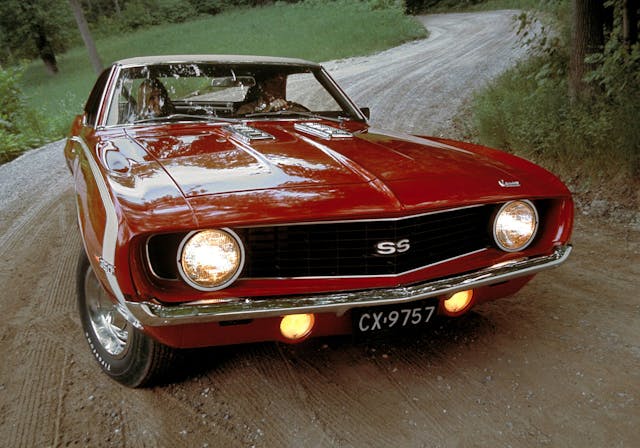1967–69 Chevrolet Camaro buyers guide
With a platform shared with the successful Chevrolet Nova, a name derived from the French word for “friend” or “comrade,” and a mission to do battle with Ford’s wildly successful Ford Mustang, Chevrolet introduced the stylish 1967 Camaro 2+2 coupe and convertible to fanfare and success both in the showroom and on the race track.
So let’s get a quick, high-level overview of the first-generation Camaro and highlight special editions, so you’ll know which examples are best for you.
1967

It’s no surprise that over 220,000 customers chose the new Camaro: the long-hood, short-deck styling was complemented by strong character lines along the hood and body side, curvaceous rear fenders, and an elegant roofline meeting a clean rear deck. And the look was complemented by a host of options to ensure the 1967 Camaro was custom tailored to the buyer’s need.
With two inline-six engines (230/250 cubic inches with 140/155 horsepower) , two 327-cu-in small-block V-8s (210/275 hp), a 302 small-block (Camaro Z28), a 350 small-block (L48, 295 hp), two 396 big-block V-8s (L35/L78, 325/375 hp) complete with an assortment of manual and automatic transmissions, the Camaro catered to all performance needs.
Sporting an interior with styling similar to the upcoming C3 Corvette, the Camaro had a plethora of factory and dealer-installed options including: air conditioning, tinted windows, power windows, shoulder belts, floor console, cruise control, headrests, three radio options, rear window defogger, a fold-down rear seat, and Z23 (bright metal trim) or Z87 (unique wood trim) interior upgrade package.

Exterior options were similarly comprehensive: vinyl top, simulated wire wheel covers, rally wheels, a Z21 cosmetic upgrade, and the Rally Sport (RS, Z22) option. The RS spiced up the Camaro’s exterior with covered headlights, larger brake lights (the reverse lights moved below the bumper), extra chrome trim, and RS badging.

The Super Sport (SS) Camaro was a performance upgrade mandating either the 350 or 396 V-8 and included performance suspension, SS badging, a unique hood with non-functional chrome air intakes, and a stripe circling the front fascia. The RS package was also available on SS models.

For those interested in performance on a road course, a mid-cycle upgrade for the Camaro came in a Z/28 trim level designed specifically for SCCA Trans Am Series. Complete with a high-revving, solid lifter 302 V-8 engine, four-speed manual, 15-inch rally wheels, uprated suspension, “302” emblems on the fenders, and racing stripes down the center of the hood/roof/trunk, sadly only 602 Z/28s were made. While this was a race car built for the street (air conditioning and automatic transmissions were unavailable), the RS package was also available for Z/28 buyers.
1968

Styling changes were significant for the second year of production: federally-mandated side marker lights, revised grille with rectangular front parking lamps, engine displacement emblems moved to the front of the fenders, square side view mirrors, taillights subdivided into four rectangles, and the deletion of vent windows in lieu of General Motor’s in-cabin Astro Ventilation system.
A redesigned interior sported a new center console, dash, and armrests with extra padding, redesigned console gauges (moving the clock into the tachometer, creating the famous Tic-Toc-Tach), and the replacement of many chrome finishes for aluminum to reduce glare.
As Camaros were meant to be driven harder than a normal Chevy Nova, revised rear shock mounting points helped reduce last year’s axle hop issues. For big-block equipped units, multi-leaf springs also replaced the composite single leaf springs at the rear. A new, entry-level 396-cu-in (L34) V-8 made a robust 350 horsepower, but the top-level L78 could now be ordered with aluminum heads (L89) for significant weight savings.
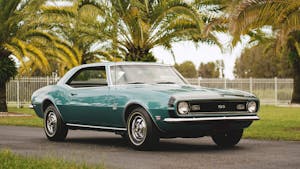
Depending on engine and build date, Camaro SS models had unique hood louvers: small-block (L48) used the carryover simulated louvered hood insert from last year while big-blocks featured a squared-off design with four ports per side. Finding conclusive information on this has been difficult to come by, but it is believed that some 1968 Camaro SS hoods were delivered with the 1967 louvers.

Sales improved significantly for the Camaro’s sophomore year, up to 235,147 units for all models. Most notably, thanks to a one-off Z/28 convertible made especially for Pete Estes (Chevrolet General Manager) to fall in love with, this model now received the marketing it deserved and sold a robust 7199 units.
1969
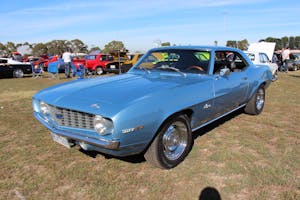
Plenty of new bodywork greeted buyers of the 1969 Camaro, starting with a sharply angled grille and sleeker doors, fenders, quarter panels (with fake louvers), and rear fascia: all combining to provide visual speed to the Camaro’s body. Taillights rounded out the changes as they switched to a triple pod design. A distinctive cowl induction hood and plastic “Endura” front bumper (painted to match) were also available.
Variable effort power steering and a new four-wheel disc brake option (JL8) were new, the latter was likely intended for serious racers looking at the Z/28 performance with Corvette-worthy brakes. All models equipped with a four-speed manual now had Hurst-branded shifters. While both six-cylinder engines remained, a new 307 V-8 (L14) made 200 horsepower and two new 350 V-8s made a full 250 (L65) or 255 (LM1) horsepower. While the SS still had a small block (L48, 300hp) and a 396-cu-in big-block (L35, 325hp) available, Chevrolet’s Central Office Production Order (COPO) created two options: a 427 V-8 at 425 hp (L72) or the all-aluminum ZL1 big-block with an underrated 430 hp.
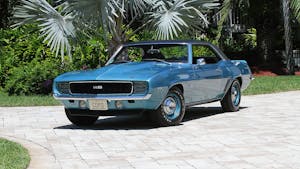
The RS continued with numerous trim enhancements, most notably body-color painted headlight doors with tri-bar grille inserts and headlight washers. Prominent “RS” lettering on the front and rear fascias made the option package clear if the extra body trim and unique reverse lights weren’t enough for the viewer. Interior changes were significant: a new dashboard with a square gauge cluster greeted the driver, the ignition switch moved to the steering column, headrests were now standard, and the woodgrain pattern changed.
Thanks to all the changes and upgrades, the Camaro sold even better: 243,085 units found homes in 1969, but some credit is due to a longer model run as the redesigned 1970 Camaro had delays in production. While the first-generation Camaro has legions of fans for good reason, let’s briefly discuss the unique and highly desirable special edition Camaros.
Special Editions:
1967/1969 Pace Car Replicas
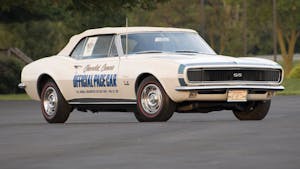
The 1967 Pace Car replicas were finished in Ermine white with blue interior/trim/stripe atop a Camaro convertible in RS/SS configuration. Chevrolet made an estimated 104 Camaro Pace Cars for 1967. The Pace Car door decals were shipped in the trunk, installed by either the dealer or the owner.
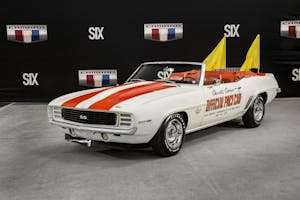
Chevy followed suit in 1969 with 130 replicas made from Camaro convertibles and hardtops, finished in Dover White with Hugger Orange stripes in a Camaro Z/28 style. All examples were ordered in RS/SS configurations with cowl induction hoods and an orange interior with distinctive houndstooth cloth inserts. Most options were also available, including the Endura bumper painted in Dover White.
Yenko Camaro (and other dealerships)

Yenko Camaros were special in the fact that the selling dealership, Yenko Chevrolet, ordered the hottest big-block V-8s from Chevrolet’s parts bin and installed them in brand new Camaros ready for delivery. In 1967, Yenko ordered approximately 106 units of the L78 Camaro SS and replaced it with the 427 V-8 (L72), rated at 450 horsepower, while adding a custom fiberglass hood and custom gauges.
For 1968, the Yenko Camaro started off as an SS with the suspension and speedometer upgrades found in COPO 9737 and once again added the L72 big-block. Custom striping and spoilers (later builds received factory spoilers) a fiberglass hood, custom gauges, and Yenko/427 decals rounded out the cosmetic differences for the 64 units made.
In 1969, Yenko took advantage of the COPO system to order 201 Camaros with the L72 motor, cowl induction hood, disc brakes, and suspension and powertrain improvements, then added Yenko graphics, 427 emblems, and the signature sYc (Yenko Super Car) logo.

This was also the year that L72 Camaros were ordered by other dealers using the COPO system for their own special versions: Berger Chevrolet (ordered some with desirable cosmetic/trim options), Scuncio Chevrolet, Jack Douglass Chevrolet (but sold as Yenkos), and Emmert Chevrolet (special order colors and trim).
Baldwin Motion (Baldwin Chevrolet) deserves special attention for running with Chevrolet’s engine and performance upgrades and building highly modified examples with drag race-friendly suspensions and custom bodywork. Learn more about Baldwin Motion here.
COPO Camaro
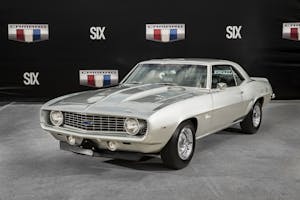
COPO, Chevrolet’s Central Office Production Order system, created the 1969 COPO Camaro with an uprated suspension and powertrain in either an L89 big-block (COPO 9561, which is an L72 with aluminum heads) or ZL1 all-aluminum big-block (COPO 9560) configurations to an otherwise low option Camaro. Around 1000 units were sold to Chevrolet dealerships, including Yenko Chevrolet for their custom Camaro.
Mandatory suspension and powertrain upgrades to handle the big power increase added to the base price, but the COPO L72 model was still only $489.75 above that. Not so for the aluminum ZL-1, which was $4160 above the price of a base Camaro. Only 69 ZL-1 COPO Camaros made production.
